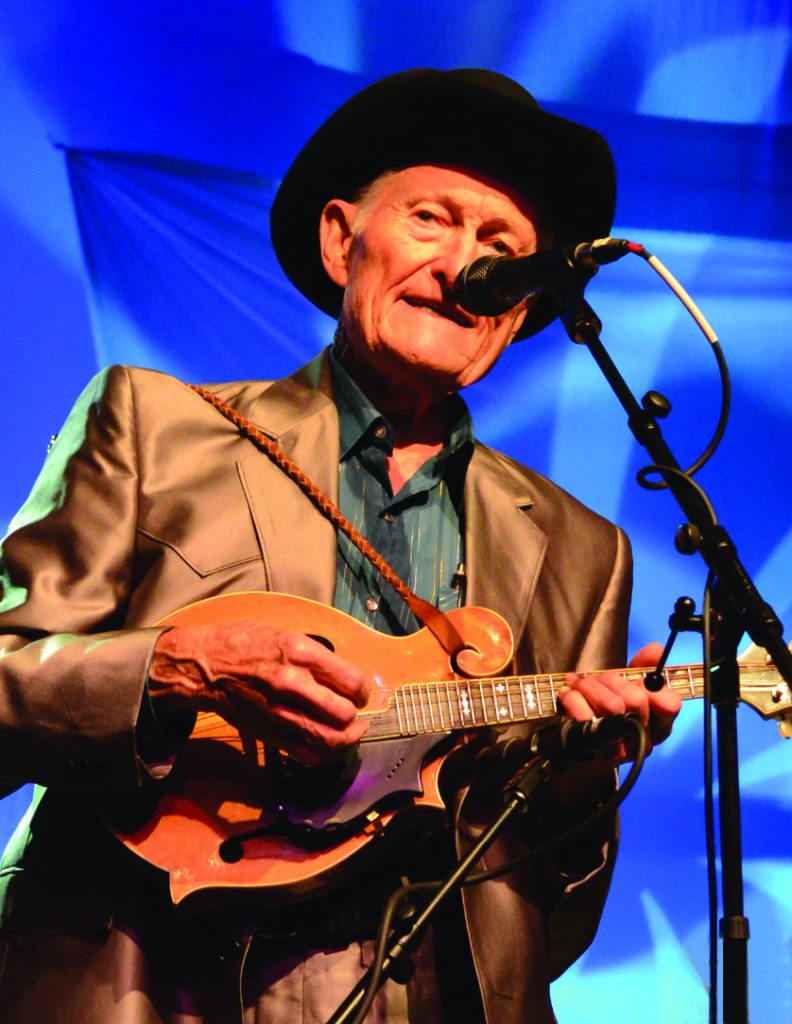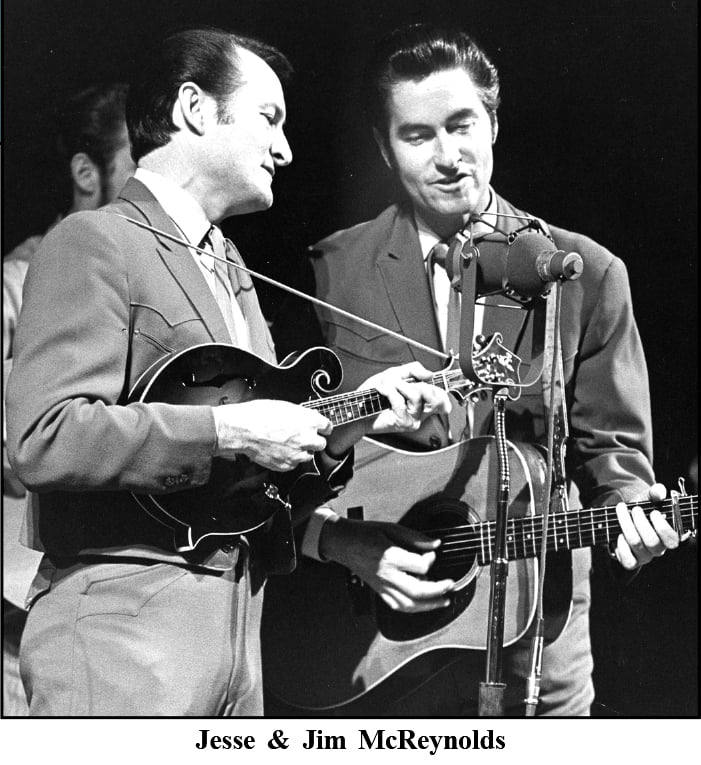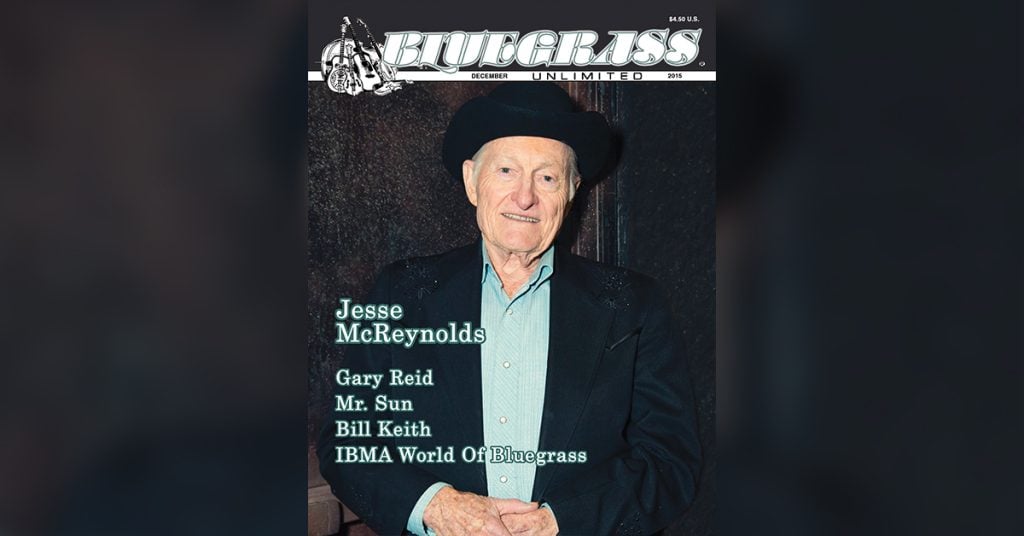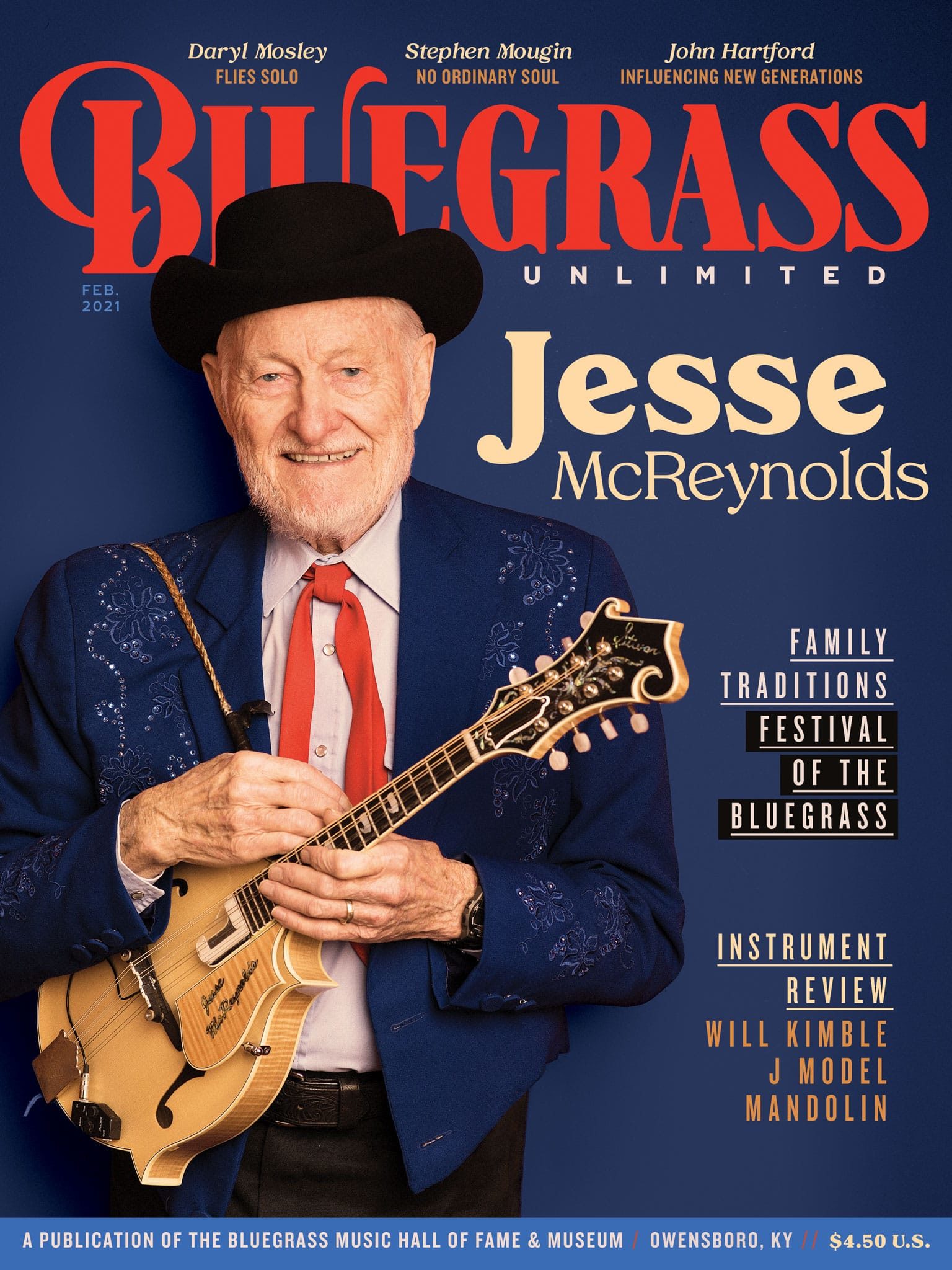Home > Articles > The Archives > Jesse McReynolds – Still Going After 68 Years in Bluegrass
Jesse McReynolds – Still Going After 68 Years in Bluegrass
Reprinted from Bluegrass Unlimited Magazine
December 2015, Volume 50, Number 6
IBMA Hall Of Famer Jesse McReynolds certainly has nothing to prove after devoting 68 years to bluegrass music. He easily could have decided to retire from the business and rested on his accomplishments as one half of the famous bluegrass duo Jim & Jesse. Instead, the 86-year-old performer still has a passion for music.
“I’ve still got a lot to learn.” McReynolds said from his Pick Inn in Gallatin. Tenn. He had returned earlier that Sunday from the World Of Bluegrass in rain-soaked Raleigh. N.C. “I hear these young new pickers play and I think. ‘God. where are they coming from?’ Their talent is amazing.
“I still experiment.” he said. “I’ll hear something sometimes out of the clear blue sky that’ll make a nice instrumental. I’ll jump in and do it. Sometimes I’ll get up and I can’t wait to get through eating to get to my mandolin to start saying. ‘What did I think about last night?”’ Unfortunately. he says, the normal effects of aging are slowing his reflexes and therefore the speed of his playing. “I try to do things that I can handle. I listen to things I did twenty and thirty years ago. Gosh. I could play fast! I could play like a banjo player with a straight pick. As you get older, it don’t work as good as it used to.”
Despite a minor health issue in 2014. the octogenarian still hits the road for festivals, makes guest appearances at gigs such as the Station Inn with Carl Jackson and friends, and regularly performs at the Grand Ole Opry. (This year, he celebrated his 51st year as a member.)
Bull Mountain Moonshiners
For his next project, the bluegrass legend wants to pay homage to one of the driving influences in his early musical life, Grandfather Charles McReynolds. Jesse’s grandfather played on the infamous Bristol Sessions, dubbed by many as the Big Bang Of Country Music. During a 12-day session in 1927 from July 25 to August 5, producer Ralph Peer along with the Victor Talking Machine Company recorded 19 performers, including the Carter Family, Jimmie Rodgers, and Ernest V. “Pop” Stoneman. Grandfather McReynolds’ family band, the Bull Mountain Moonshiners, recorded “Sweet Marie” (which was never released) and “Johnny Goodwin” (which Jesse always knew as “The Girl I Left Behind Me”).
The younger McReynolds picked up his grandfather’s original fiddle and recreated “Johnny Goodwin” for Orthophonic Joy: The 1927 Bristol Sessions Revisited that was released earlier this year. Produced by Grammy-winning musician/songwriter/producer Carl Jackson, the project features a stellar line-up of artists performing songs from the earlier record session. “I was trying to play things as close as I could to the way he’d done it,” McReynolds said. A few feet away from where McReynolds sits is an old black case that contains the Stradivarius fiddle.
Charles McReynolds lived in the coal-mining community Possum Hollow near Coebum, Va., beckoning to the mountain with his bow against the strings. “I heard him play quite a bit when I was in my teens,” Jesse recalls. “We’d go to his house, and he’d be sitting there with the window open and looking up to see if anyone was coming. He’d sit there and play the fiddle. You could hear it all over the holler.”
Other times, Jesse remembers family and neighbors visiting his house for a fun jam session on Saturday nights. “Everybody had a fiddle or banjo back then. We had very few radios. Of course, there was no television. I remember my mom used to roll up the linoleum rug and put it on the back porch because they’d get in and start dancing and they’d tear up a rug pretty quick. We’d have music at our house quite a bit on Saturday night. I was only seven or eight back then. I’d get up on Sunday morning, and people would be laying in the living room on the floor,” he chuckles. “My momma tried to get some of them to use the bed. ‘No, this’ll be fine.’ Sometimes, they’d get too much moonshine mixed in with their music, and they’d get into a disagreement. I remember one time my dad was playing music, and they got to arguing over a tune or something. This guy tried to push my dad around. Dad took the banjo and knocked him out with it!”

“I’ve been trying to work on the fiddle quite a bit,” he continues. “I wrote a tune about my grandfather’s fiddle for the album I’m working on. I decided to build the project around the fiddle instead of just me. I’ve got a lot of fiddle players coming in to play and use that fiddle.”
McReynolds is attempting to recreate that culture and the accompanying music for the project he’s naming after his grandfather’s family band with the instrumental he just wrote, “The Bull Mountain Moonshiners.” He and several other musicians are recording old-time tunes such as “Leather Britches,” “Soldiers Joy,” “Trouble Among The Yearlings,” and “Johnny Blacksmith,” to name a few. He also plans to incorporate into the recordings an antique banjo one of his uncles played (now owned by his niece), plus a photo of his grandfather’s old homeplace long since demolished following the ravages of strip mining. So far, he’s brought Jim Brock, Steve Thomas, and Michael Cleveland into the studio. He’s put down tracks for “Arkansas Traveler,” “Carroll County Blues,” and “Angeline The Baker.”
Branching Out
While Jesse loves performing the old-time tunes, he doesn’t limit his creativity. His drive and devotion to music allows him to explore other genres. In 2010, he started tapping into the Grateful Dead crowd when he released Jesse McReynolds & Friends with David Nelson & Stu Allen, Songs Of The Grateful Dead: A Tribute To Jerry Garcia & Robert Hunter. “I tried to do some things that I wanted to do all through the years. That was one of the best things I’ve done since Jim passed away.”
His venture off the bluegrass path was well-rewarded when the Grateful Dead fans welcomed him into their fold. “You get into the Grateful Dead audience, and they’ll stay with you,” McReynolds said. “I got to meet Jerry’s wife and daughter and a lot of the guys who worked with him. They all put their approval on it. I thought about doing it pretty much bluegrass.” After some reflection, he opted to approach the material in a manner acceptable to the Grateful Dead fans. “I did a variety of their music. I made the tunes too long for radio play. I shortened a couple of songs, and radio played it.” McReynolds turned to his wife, Joy, for choosing which of the Grateful Dead’s songs to select. “I told [WSM Grand Ole Opry announcer] Eddie Stubbs, ‘My wife’s a Deadhead.’ He said, ‘What did you say?’ She’s a fan of them from way back before we met. We traveled together a lot when we first got married, and she was always playing Jerry Garcia and talked about what a great guitar player he was. I found out he was!”
In support of the CD, the traditional bluegrass artist plugged in for some electrifying shows with Old Crow Medicine Show. “Now, there’s a group that’s got it together. We played up in Roanoke, Va. They had five or six thousand people there. They don’t sit down. They stand up! They’re dancing! They turn things wide open. It’s completely different than anything in bluegrass. They played old-time tunes. We did ‘9 Pound Hammer’ and some of the things we had recorded. It was a little heavy,” he adds with a laugh.
At the end of that show, Old Crow performed a jamming salute to the Grand Ole Opry’s 90th Anniversary, and the crowd apparently loved it. “When they got to the finale, I saw this stuff flying up on stage,” Jesse recalls. “When things were over, I looked over on the microphone, and there was a bra hanging on the microphone!”
On the other hand, McReynolds’ musical moves outside bluegrass haven’t necessarily been met with bluegrass fans’ approval. It’s not the first time he caught flak for stepping outside of the box. He played mandolin on the song “Runnin’ Blue” on The Doors 1969 album The Soft Parade and he recorded a rendition of the theme to the movie Dr. Zhivago called “Somewhere My Love” on his first instrumental album.
“Even my brother Jim wouldn’t accept it that well. I did a lot of picking on the backseat of the bus,” he laughs. “The comment I got from a lot of other musicians: ‘That’s not bluegrass.’ I just don’t let one or two people lead me in a different way. I sort of do my own thing. Eventually, it took a while to get some of it to go through. I’m still fighting that battle. I hope I don’t insult sometimes, by some of the things I do. So far, it’s all been positive. That’s what it’s all about. If you’re going to play music, you do what you want to do, I guess.”
Oddly enough, Jesse admits not feeling completely in the fold with bluegrass aficionados, nor was he happy with the quality of the music Jim & Jesse produced. “I didn’t believe we were that good back then, the way it sounds to me now,” he says. “When we were doing straight bluegrass, I had this feeling that we were not being accepted like I would like to have been. I think sometimes, we didn’t contribute that much. The music we played, for some reason, didn’t catch on nothing like Flatt & Scruggs or Bill Monroe or anything like that.”
Being one of the few surviving pioneers of the genre, McReynolds says bluegrass fans have cultivated a newfound respect for Jim & Jesse. “I think we get recognized more now than we did back when we were actually doing it,” he said. “People wonder where all this came from. More people are getting interested in the history of the music.”
He’s also gamering more attention lately for his mandolin playing. “I always thought I was sort of in the background as a mandolin player. I never had the pleasure of accepting an award as a mandolin player.” In the early days, McReynolds says people were more confused than complimentary of his playing. “People complimented the band on our banjo player and our guitar player and our fiddle player,” he recalls. Then they would ask, ‘What’s that little thing you play?’ I had a hard time explaining what it was, not how I played it!”
Moving On

Jesse has no plans to retire. He had difficulty adjusting after his brother, Jim, died of cancer in 2002. “I really didn’t know hardly what to do when he passed away. You get tied together sometimes. Some things don’t separate.” Jim & Jesse performed 55 years as a brother act with the Virginia Boys. During that time, Jesse concedes that the siblings had their troubles, but nothing that would cause them to ever break up. “He would go his way, and I’d go my way, and we’d get together and go on. That’s life.”
While Jesse relishes the chance to pursue other opportunities as a solo act, not having Jim by his side has left a void. “If I dream about playing a show somewhere, Jim is always there,” he says. “He’s a part of it. I’ve never had a dream about me playing solo. There’s some parts of your life that won’t leave you like that. He’ll always be a part of the music I do.”
Three of Jesse’s grandchildren used to perform with him. His grandson, Luke, played mandolin. “If I’d start feeling like I was slipping on a tune, he’d come out with the mandolin. That right hand of his was like mine used to be. I’d let him play, and I’d stand behind him and play behind him a little bit.” Now, Luke has landed a job driving buses for country music stars. Jesse’s granddaughter Amanda, who used to sing lead and harmony, married and began working a regular job.
Another grandson, Garrett, continues to work with Jesse as his guitarist and takes over the tenor parts that Jim once sang. Also in the band are Gary Reece on banjo, Steve Thomas on fiddle, Larry Carney on lead guitar, and Joseph Smith on bass.
“My plans for the future are to continue playing the Grand Ole Opry when I’m not out playing festivals, complete my mandolin project with David Grisman, and finish my project with my grandfather’s fiddle. We have a lot of Jim & Jesse TV shows coming out on DVD in 2016. I’m finally building a home recording studio, writing a lot of new songs and tunes, recording with other bands, and with my wife’s help, writing a book about my musical career.”

